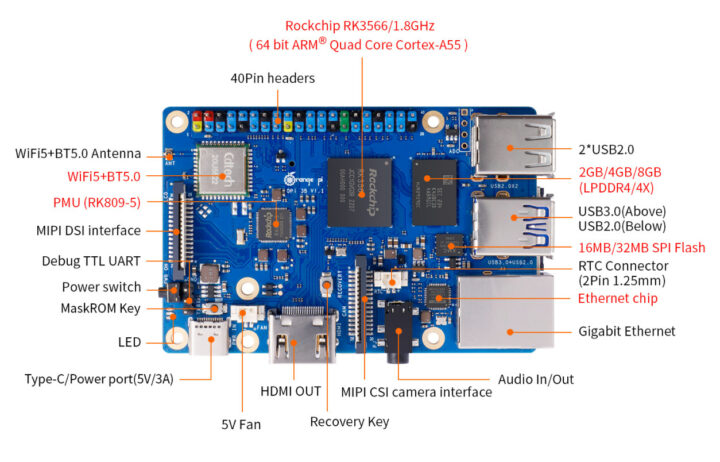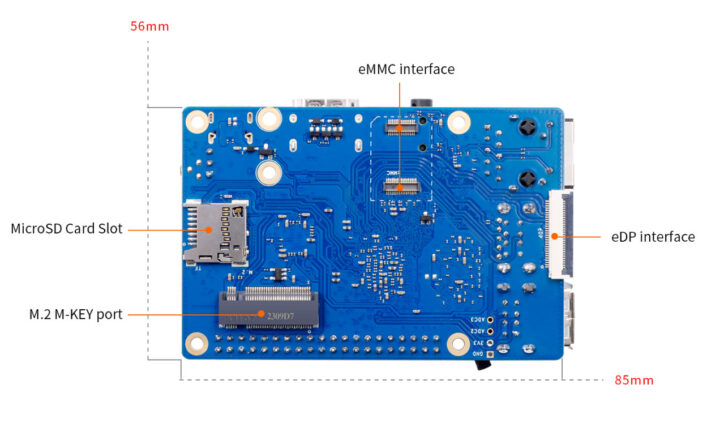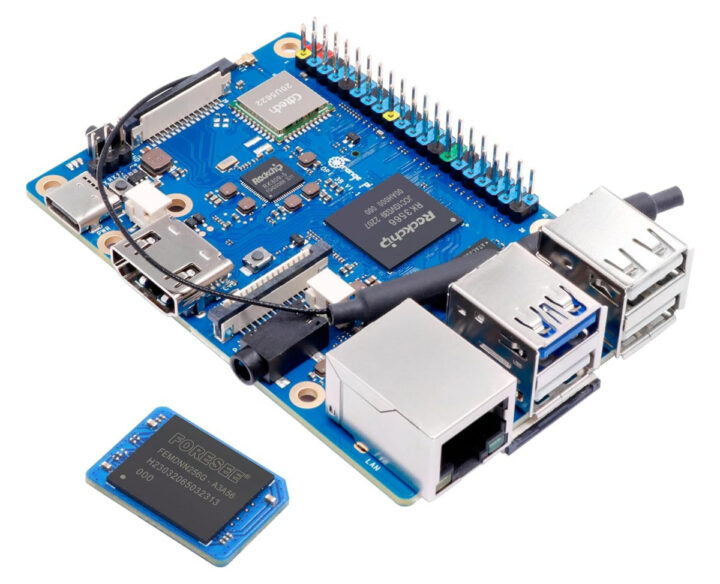Orange Pi 3B is a new Rockchip RK3566 SBC that’s like a supercharged Raspberry Pi 3B board with the same form factor, but with a faster processor, up to 8GB RAM, and support for multiple storage options with a microSD card slot, an eMMC flash socket, an M.2 Key-M socket for NVMe (PCIe 2.1) or SATA III SSDs, as well as an SPI flash that should enable features like network boot.
The board also features HDMI 2.0 and eDP display intefaces, a Gigabit Ethernet port, a WiFI 5 and Bluetooth 5.0 wireless module, four USB ports, MIPI DSI and CSI connector, and the 40-pin Raspberry Pi GPIO header. It’s powered through a USB-C port taking 5V instead of the micro USB port found in the Raspberry Pi 3B.
Orange Pi 3B specifications:
- SoC – Rockchip RK3566
- CPU – Quad-core Cortex-A55 processor @ up to 1.8 GHz
- GPU – Arm Mali-G52 2EE GPU with support for OpenGL ES 1.1/2.0/3.2, OpenCL 2.0, Vulkan 1.1
- NPU – 0.8 TOPS AI accelerator with support for Caffe, TensorFlow, TFLite, ONNX, PyTorch, Keras, Darknet
- VPU
- 4Kp60s H.265, H.264, VP9 video decoding
- 1080p100 H.265 video encoding
- 1080p60fps H.264 video encoding
- Process – 22nm
- System Memory – 2GB, 4GB, or 8GB LPDDR4/4x
- Storage
- eMMC module socket (16GB, 32GB, 64GB, 128GB, or 256GB capacity)
- 16MB or 32MB SPI flash
- M.2 M-Key socket for SATA III or PCIE 2.0 NVMe SSD
- MicroSD card slot
- Video Output – HDMI 2.0 up to 4Kp60, 2-lane MIPI DSI, eDP 1.3
- Camera I/F – 2-lane MIPI CSI connector
- Audio – 3.5mm headphone jack, digital audio output via HDMI
- Networking
- Gigabit Ethernet RJ45 port via YT8531C transceiver
- Dual-band WiFi 5 and Bluetooth 5.0 via CDTech 20U5622 module (aka Allwinner AW859A)
- USB – 1x USB 3.0 host port, 2x USB 2.0 host port, 1x USB 2.0 Device/Host port
- Expansion – 40-pin Raspberry Pi compatible GPIO header with up to 28x GPIOs, UART, SPI, I2C, PWM
- Misc
- MaskROM key, Reset key, Power key
- 2-pin 5V fan connector
- 2-pin RTC battery connector
- Power Supply
- 5V/3A via USB Type-C port
- Rockchip RK809-5 PMIC
- Dimensions – 85 x 56 mm
- Weight – 49 grams

 Orange Pi provides a long list of operating systems with Android 11, Ubuntu 22.04, Ubuntu 20.04, Debian 11, Debian 12, OpenHarmony 4.0 Beta1, Orange Pi OS (Arch), Orange Pi OS (OH) based on OpenHarmony, and others. It’s unlikely all those images get the same level of support, so users will have to find which one works best for them… More technical details should soon become available on the wiki, and the images will be available on the download page. The Orange Pi 3B is not yet listed there at the time of writing.
Orange Pi provides a long list of operating systems with Android 11, Ubuntu 22.04, Ubuntu 20.04, Debian 11, Debian 12, OpenHarmony 4.0 Beta1, Orange Pi OS (Arch), Orange Pi OS (OH) based on OpenHarmony, and others. It’s unlikely all those images get the same level of support, so users will have to find which one works best for them… More technical details should soon become available on the wiki, and the images will be available on the download page. The Orange Pi 3B is not yet listed there at the time of writing.
Interestingly the new Orange Pi 3B has nothing to do with the Orange Pi 3 SBC introduced in 2019 with an Allwinner H6 processor and a different form factor, then followed by an LTS version in 2021, so don’t get confused. It’s not the first Rockchip RK3566 SBC that follows the Raspberry Pi 3 Model B form factor either, as we previously covered Geniatech’s XPI-3566. But the Orange Pi 3B board has more features such as an M.2 SSD socket and will be easier to purchase for individuals.
Six versions of the Orange Pi 3 SBC are currently available on Amazon for pre-order:
- $34.99 with 2GB RAM
- $51.99 with 2GB RAM and a 256GB eMMC flash module
- $39.99 with 4GB RAM
- $57.99 with 4GB RAM and a 256GB eMMC flash module
- $50.99 with 8GB RAM
- $67.99 with 8GB RAM and a 256GB eMMC flash module
There’s also a $5 discount coupon on Amazon. As usual, pricing for Orange Pi boards is good value for money provided software support follows. Deliveries are scheduled to start on August 15. The boards are now also available on Aliexpress for $30 and up. Further details may be found on the product page.

Jean-Luc started CNX Software in 2010 as a part-time endeavor, before quitting his job as a software engineering manager, and starting to write daily news, and reviews full time later in 2011.
Support CNX Software! Donate via cryptocurrencies, become a Patron on Patreon, or purchase goods on Amazon or Aliexpress






Can we please stop using this crappy form factor already?
Exactly!
It would be great for use in all the pi-top [3]’s hanging around in school IT labs!
However, the HDMI and 3.5mm jack positions would need to be in *exactly* the same positions as they are on the RPi3B+ so that it and the hub line up correctly with the thermal bridge – already been burned by the Radxa Rock 3A in that regard; the HDMI port component is such that it sticks out about 2mm further than on the RPi3B+ (or at least that’s the excess when connecting it to the hub), meaning you can’t fit the thermal bridge from the GPIO pins to the hub.
Orange Pi3B 2GB RAM version is 25USD after discount,4GB RAM version is 30USD after discount,8GB RAM version is 40USD after discount.
Not from Amazon.
The 2GB is $29.99 with $9.99 shipping
The 4GB is $34.99 with $9.99 shipping
The 8GB is $45.99 with $9.99 shipping
The $10 shipping is pretty insane.
And that’s with the $5 coupon.
Amazon charges extra cost, which is more expensive.
It’s indeed a good deal for the fairly complete features. They’re not taking much risk regarding software suport, as the RK356x are now fairly well supported in mainline. My Odroid-M1 runs on mainline BTW.
And I agree with TLS that it would be about time that vendors abandon this totally obsolete and counter-productive form factor. There have been sufficient examples of better alternatives from Radxa, Khadas, FriendlyElec, HardKernel, Pine and probably others I’m not immediately thinking about, to confirm that the worst option when one wants to exploit the possibilities of an SoC remains the current Pi form factor (well, after the 96boards one of course).
I thought immediately why they made the connector placements compatible to RPi 3B and prior and not 4B?
Most probably since this thing is designed to be a drop-in replacement for products built around older RPi. The M.2 socket makes it incompatible with vast majority of RPi enclosures so maybe Xunlong did this board specifically for a commercial customer phasing out RPis and sells it to consumers anyway?
Yeah, or maybe as they never really care about enclosures, they count on the fact that buyers will only check the photo first, will order it, and will then discover it doesn’t fit into their existing one so they’ll buy another one but the device will have been sold already.
This is what I’m worried about.
I think if SBC manufacturers are going to market their boards as “RPi3B- ” or “RPi4-compatible” then they need to do so like Waveshare did with their RPiCM4-to-RPi3B-Adapter-Board so that end users can be sure such boards will fit just fine in their existing cases.
This used to be the case but quickly customers wanted to see some connectors replaced (e.g. USB-C for power input) so it already wasn’t going to be 100% compatible anymore.
Ok sure, the USB-C requirement means we won’t get 100% compatibility – and that wouldn’t be a problem in the pi-top [3], for example, though I do see that other RPi3 cases would require a very small amount of modification to the hole for the microUSB port – but Waveshare didn’t say their adapter board would be 100% compatible, just that they wanted to get as close as possible to the RPi3B+ form factor, down to the millimetre.
I’m hoping for Xunlong adding a mechanical SATA adapter like e.g. this to their store so such a thing known to work can be ordered together with the board.
Oh that’s nice. I saw this version as well that seems to pull power as well.
https://www.aliexpress.com/item/32858659048.html
> that seems to pull power as well
The M.2 socket provides only 3.3V so if this thing uses boost converters to generate 5V and 12V from the M.2 socket’s 3.3V I would never ever rely on this. Too many HDD and SSD issues (with external disks often misunderstood as ‘USB issues’) are related to instable powering.
For this one it’s probably not that bad, and could even be better than the alternatives consisting in stealing the power from USB. The board only produces the 5V output, and the 3.3V rails on M2 connectors are generally quite powerful when you see how much such an SSD can heat. I don’t know the specs but it’s very likely more than what can be pulled from a USB-A connector. Actually I’ve been missing such a 5V boost converter on boards that provide a PCIe connector. I can understand the reason, they don’t want users to plug a GPU on these, but for small NICs or SATA controllers that would be more than enough.
> I don’t know the specs
The M.2 M-key specification has 9 pins for voltage supply rated for 3.3V and are not supposed to exceed 0.5A per pin, which yields a maximum around 15W.
Good luck with this on a SBC that is powered by a 5V/3A power source that probably will not even get 15W due to the usual voltage drop with higher amperages.
Sure but it’s exactly the same problem when installing an NVME SSD.
What size of m.2 fit on that board ?
It looks like 2230 and 2242.
Is the power consumption of RK3566 lower than that of Raspberry Pi 4b? Thanks
If we compare Rockchip RK3566 quad-core Cortex-A55 processor @ 1.8 GHz to the Broadcom BCM2711 quad-core Cortex-A72 processor @ 1.5 GHz, then the chip itself should consume less under load since Cortex-A55 cores have been found to be rather efficient. But at the board level (Orange Pi 3B vs Raspberry Pi 4B) it would have to be tested since other components and the power circuitry need to be taken into account.
Thanks !
Does anyone tested a SATA M.2? It is unclear: on the web site the say both but on the pdf manual they say only M.2 NVMe.